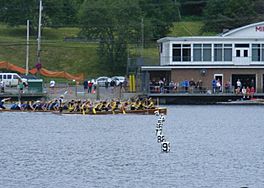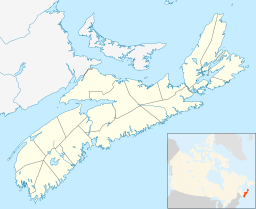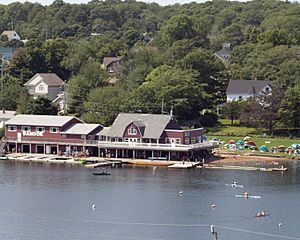Lake Banook facts for kids
Quick facts for kids Lake Banook |
|
|---|---|

A C-15 (Canoe Sprint) race on Lake Banook in 2009.
|
|
| Location | Dartmouth, Nova Scotia, Canada |
| Coordinates | 44°40′51.2″N 63°33′24.9″W / 44.680889°N 63.556917°W |
| Primary inflows | Shubenacadie Canal |
| Primary outflows | Shubenacadie Canal, Sullivan's Pond |
| Basin countries | Canada |
| Max. length | 1,210 m (3,970 ft) |
| Average depth | 38 ft (12 m) |
| Surface elevation | 20 m (66 ft) |
| Settlements | Dartmouth |
Lake Banook is a cool freshwater lake in Dartmouth, Nova Scotia, Canada. It's a super active spot! You'll find three clubs for canoeing and kayaking, two rowing clubs, and even a dragon boat club here. Some people also believe it's where ice hockey first started!
Contents
Where is Lake Banook?
Lake Banook is easy to find in Dartmouth. On its east side, you'll see Prince Albert Road, which is part of Trunk 7. The west side of the lake is next to Crichton Park, a neighborhood with homes.
At the south end of the lake, there's a special lock system. This lock connects Lake Banook to Sullivan's Pond. Up at the north end, a bridge carries Highway 111 over the water. This highway is also called the Dartmouth Circumferential Highway. This bridge also marks the border between Lake Banook and Lake Micmac.
Beaches and Water Quality
Lake Banook has a supervised beach called Birch Cove Beach. This means lifeguards are usually on duty there. Another beach, Graham's Grove, used to be open. However, it closed in the early 1990s. This happened because of construction nearby. A large road interchange was built, which affected the water quality.
How Lake Banook Changed Over Time
Lake Banook has changed a lot over the years. It used to be about two meters (six feet) shallower. It became deeper when a dam was built in the early 1800s. This dam was part of building the Shubenacadie Canal. When the water level rose, a small island in the lake disappeared underwater.
More changes happened in 1989. The top part of the paddling course was dug deeper. This was done to meet standards for the Junior World Championships. The dirt from this digging was used to make Graham's Grove Park bigger. You can still see the old access road underwater from that time.
The shoreline of the lake has also been changed. People have built beaches, private docks, and pipelines. But some natural parts of the shoreline still remain. You can find these natural spots at the north end of Brookdale Crescent Park, the north end of Birch Cove, and parts of Grahams Grove.
History of Lake Banook
The name "Banook" comes from the Mi'kmaq language. It means "first lake." This is because it was the first lake in the system that later became the Shubenacadie Canal. The Mi'kmaq people were the first to travel on Lake Banook's waters. Their presence also led to the names of Lake Micmac, Mic Mac Mall, and Mic Mac AAC.
Lake Banook and the Birth of Hockey
Some people say that ice hockey started right here on Lake Banook! Games were played on the frozen lake as early as 1827. By 1850, it was definitely happening. Back then, the game was sometimes called "rickets" or "wicket."
In 1864, a company called Starr Manufacturing in Dartmouth started making the world's first modern ice skates. This company was less than a kilometer from Lake Banook. These Starr skates were first used on lakes in Dartmouth, including Lake Banook. They became very popular with top hockey players. For example, six out of seven players on the 1902 Stanley Cup Champions, the Montreal Hockey Club, wore Starr skates! The Starr company made skates until the 1930s.
Before refrigerators were common, Lake Banook was also a source of ice. People from both Halifax and Dartmouth would get ice from the lake for their homes.
Paddling and Rowing History
Since 1903, Lake Banook has been a hub for water sports. That's when the Banook Canoe Club was formed. Many people enjoy competitive and fun canoeing, kayaking, and rowing here. Dartmouth actually has more paddlers per person than anywhere else in Canada!
Sports on Lake Banook
Lake Banook is a very important place for water sports. It is home to three sprint canoe and kayak clubs. These clubs are all located close together at the south end of the lake. They are the Banook Canoe Club, Senobe Aquatic Club, and Mic Mac Amateur Aquatic Club. Having all three clubs so close is special in Canada. It has created a fun and healthy competition between them. All three clubs have helped train many Olympians, National Champions, and World Championship team members.
International Race Course
During the summer, Lake Banook has an amazing 1000-meter sprint canoe and kayak race course. This course is good enough for international competitions. It has nine racing lanes, each nine meters wide. The starting line for the 1000-meter race is at the north end of the lake. The finish line is at the south end.
On the western shore, there's a three-story tower for judges. It's built above the lake at the finish line. This allows officials to clearly see who finishes first in races. This course is used for many local and national competitions every year.
Lake Banook has also hosted many big world-class events:
- The canoe/kayak and rowing events at the first Canada Summer Games in 1969.
- The World Junior Canoe Sprint Championships in 1989.
- The Senior World Canoe Sprint Championship in 1997.
- The World Canoe Marathon Championship in 2001.
- The Senior World Sprint Championships in 2009.
Lake Banook will host the Senior World Sprint Championships for the third time in 2022. No other place outside of Europe has hosted this championship so many times!
Rowing and Dragon Boating
The lake is also used for local rowing competitions. It is home to both the Mic Mac AAC rowing club and the North Star Rowing club. However, the course isn't quite long enough for national or international rowing races. Those usually need 2000-meter courses.
Dragon boat paddling has become very popular. Because of this, a fifth boat club was started in the northeast part of Lake Banook. This club, Dragon Boat East, offers training all year round. Lake Banook is also where Halifax's yearly dragon boat competition and festival takes place.



